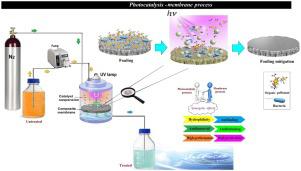当前位置:
X-MOL 学术
›
J. Ind. Eng. Chem.
›
论文详情
Our official English website, www.x-mol.net, welcomes your
feedback! (Note: you will need to create a separate account there.)
Photocatalytic-membrane technology: a critical review for membrane fouling mitigation
Journal of Industrial and Engineering Chemistry ( IF 5.9 ) Pub Date : 2021-01-01 , DOI: 10.1016/j.jiec.2020.09.031 Nazanin Nasrollahi , Leila Ghalamchi , Vahid Vatanpour , Alireza Khataee
Journal of Industrial and Engineering Chemistry ( IF 5.9 ) Pub Date : 2021-01-01 , DOI: 10.1016/j.jiec.2020.09.031 Nazanin Nasrollahi , Leila Ghalamchi , Vahid Vatanpour , Alireza Khataee

|
Abstract The present paper provides an overview of the hybrid photocatalytic-membrane process and its new properties such as permeability, hydrophilicity, rejection, antifouling and photodegradation efficiency. The integration of photocatalysts and membranes could be occurred in three major steps firstly photocatalysts mixed matrix membranes, secondly photocatalysts immobilized on the surface of membranes, and thirdly membranes for the separation of photocatalysts from their suspensions. Different combinations of photocatalysts (TiO2, CuO or ZnO) and membrane processes are presented and characterized in the review paper. Positive or negative effect of different configurations of photocatalysis and membrane processes are discussed on the antifouling and antibacterial properties of the membranes. This review outlines the coupling of photocatalysts with the membranes can reduce the fouling of the membranes due to three mechanisms: elevation of membrane hydrophilicity, induction of antibacterial properties and degradation of foulants by produced radicals. However, reactive radicals can destroy polymeric membranes. Moreover, a short introduction to the photoelectrocatalysts is presented combined with membrane processes.
中文翻译:

光催化膜技术:对膜污染缓解的批判性审查
摘要 本文概述了混合光催化膜工艺及其新特性,如渗透性、亲水性、排斥性、防污性和光降解效率。光催化剂和膜的结合可以发生在三个主要步骤中,首先是光催化剂混合基质膜,其次是光催化剂固定在膜表面,第三是将光催化剂从其悬浮液中分离出来的膜。评论论文中介绍并表征了光催化剂(TiO2、CuO 或 ZnO)和膜工艺的不同组合。讨论了不同配置的光催化和膜过程对膜的防污和抗菌性能的正面或负面影响。这篇综述概述了光催化剂与膜的耦合可以减少膜的污染,这是由于三种机制:膜亲水性的提高、抗菌性能的诱导和产生的自由基降解污垢。然而,反应性自由基会破坏聚合物膜。此外,还结合膜工艺对光电催化剂进行了简短介绍。
更新日期:2021-01-01
中文翻译:

光催化膜技术:对膜污染缓解的批判性审查
摘要 本文概述了混合光催化膜工艺及其新特性,如渗透性、亲水性、排斥性、防污性和光降解效率。光催化剂和膜的结合可以发生在三个主要步骤中,首先是光催化剂混合基质膜,其次是光催化剂固定在膜表面,第三是将光催化剂从其悬浮液中分离出来的膜。评论论文中介绍并表征了光催化剂(TiO2、CuO 或 ZnO)和膜工艺的不同组合。讨论了不同配置的光催化和膜过程对膜的防污和抗菌性能的正面或负面影响。这篇综述概述了光催化剂与膜的耦合可以减少膜的污染,这是由于三种机制:膜亲水性的提高、抗菌性能的诱导和产生的自由基降解污垢。然而,反应性自由基会破坏聚合物膜。此外,还结合膜工艺对光电催化剂进行了简短介绍。







































 京公网安备 11010802027423号
京公网安备 11010802027423号